To make a delicious aioli, start by mincing fresh garlic cloves and combining them with an egg yolk until you form a smooth paste. Slowly drizzle in extra virgin olive oil while whisking continuously to create a creamy texture. Next, add lemon juice to balance the garlic's punch, and season with salt and pepper to taste. Remember, using fresh ingredients is key for the best flavor! You can also get creative by adding herbs or spices. This tangy, creamy sauce pairs perfectly with a variety of dishes, and there's much more to explore about enhancing your aioli!
Key Takeaways
- Combine minced garlic and egg yolk to form a smooth paste for a flavorful aioli base.
- Gradually drizzle in extra virgin olive oil while whisking to achieve a creamy texture.
- Add lemon juice to balance the pungency of garlic, adjusting to your taste preference.
- Season the aioli with salt and pepper to enhance the overall flavor profile.
- Experiment with additional ingredients like herbs or smoked paprika for unique variations.
History

Aioli has a rich history that dates back to ancient Mediterranean civilizations, where it was first created as a simple emulsion of garlic and olive oil.
This basic combination quickly became a staple in various cultures, especially in regions like Provence, where it's cherished for its bold flavors.
As you explore the evolution of aioli, you'll notice it transformed from a humble condiment to a culinary delight, often enjoyed with fresh seafood and vegetables.
Over the centuries, chefs have experimented with ingredients, adding egg yolks and lemon juice, further enhancing its creamy texture.
Today, aioli stands as a demonstration of the creativity and adaptability of Mediterranean cuisine, proving that simple ingredients can create something truly extraordinary.
Recipe
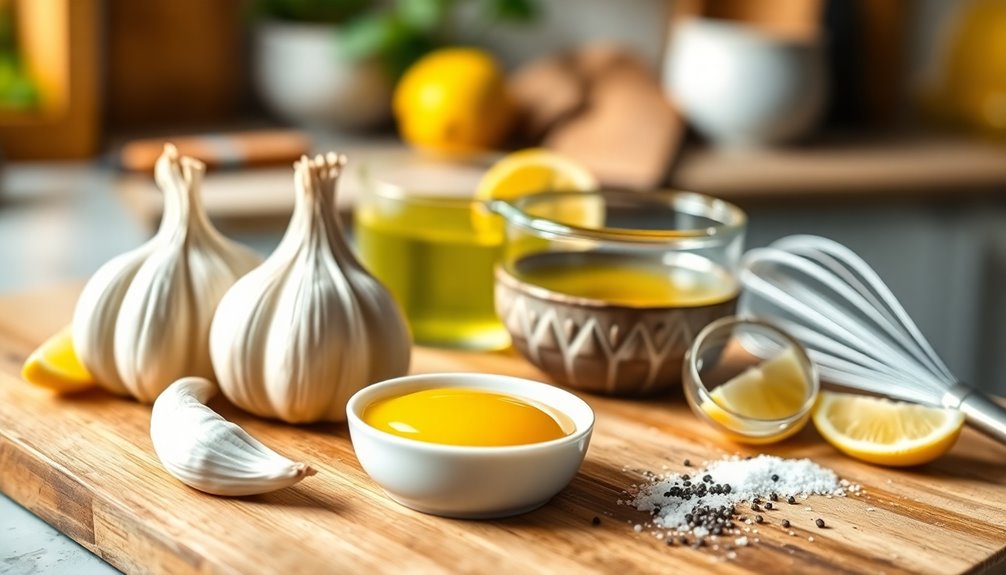
Aioli is a delicious, creamy garlic sauce that originates from the Mediterranean region, particularly Spain and France. It's a versatile condiment that can elevate a variety of dishes, from grilled meats and vegetables to sandwiches and seafood. Making homemade aioli is a rewarding experience as it allows you to control the flavors and ingredients, resulting in a fresher and more vibrant sauce than store-bought options.
To create a classic aioli, the key ingredients are simple yet impactful. The base of the sauce is typically made from garlic, which provides a robust flavor, while olive oil adds richness and creaminess. A touch of lemon juice or vinegar introduces acidity, balancing the garlic's pungency. Once you master the basic aioli recipe, feel free to experiment by adding herbs, spices, or other flavorings to suit your taste preferences.
Ingredients:
- 3 cloves of garlic
- 1 large egg yolk
- 1 cup of extra virgin olive oil
- 1 tablespoon of lemon juice
- Salt, to taste
- Freshly ground black pepper, to taste
To prepare the aioli, start by peeling and mincing the garlic cloves, then place them in a bowl with the egg yolk and a pinch of salt. Using a whisk, mix the ingredients until they become a smooth paste.
Next, while whisking continuously, slowly drizzle in the olive oil, starting with just a few drops at first to emulsify the mixture. As the aioli starts to thicken, you can gradually increase the oil flow. Once all the oil is incorporated, stir in the lemon juice and season with salt and pepper to taste.
When making aioli, it's important to use fresh ingredients for the best flavor. If you're concerned about the raw egg yolk, consider using pasteurized eggs to reduce the risk of foodborne illness.
Additionally, if you prefer a milder garlic flavor, try roasting the garlic cloves before adding them to the mixture. Finally, don't hesitate to customize your aioli by incorporating herbs like basil or cilantro, or spices such as smoked paprika for added depth.
Enjoy your homemade aioli as a dip, spread, or drizzle on your favorite dishes!
Cooking Steps
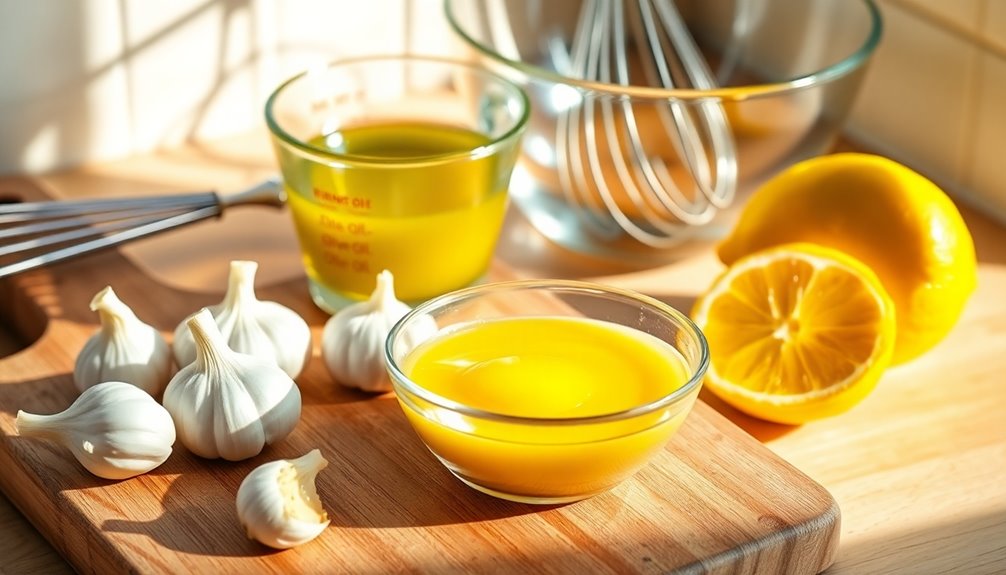
To make your aioli, you'll start by gathering fresh garlic cloves.
Next, add an egg yolk and slowly drizzle in olive oil for a creamy texture.
Don't forget to incorporate lemon juice and season with salt and pepper to perfect the flavor!
Step 1. Gather Fresh Garlic Cloves
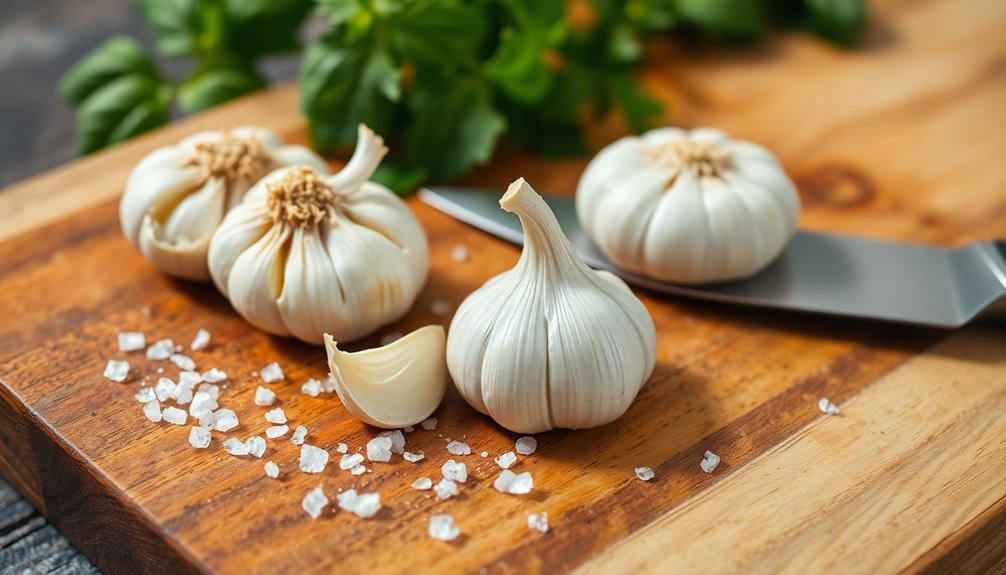
Fresh garlic cloves are the heart of a delicious aioli. To start, head to your local grocery store or farmer's market and choose firm, plump cloves. Avoid any that look dry or sprouted, as they won't pack the flavor you want.
You'll need about three to six cloves, depending on how garlicky you like your aioli. Once you've picked the best ones, peel away the outer skin, revealing the tender cloves inside. A quick tip: you can use the flat side of a knife to slightly crush the cloves, making peeling easier.
After peeling, give them a rough chop to release their aromatic oils, which will elevate your aioli. Now you're ready for the next step in creating this flavorful condiment!
Step 2. Add Egg Yolk
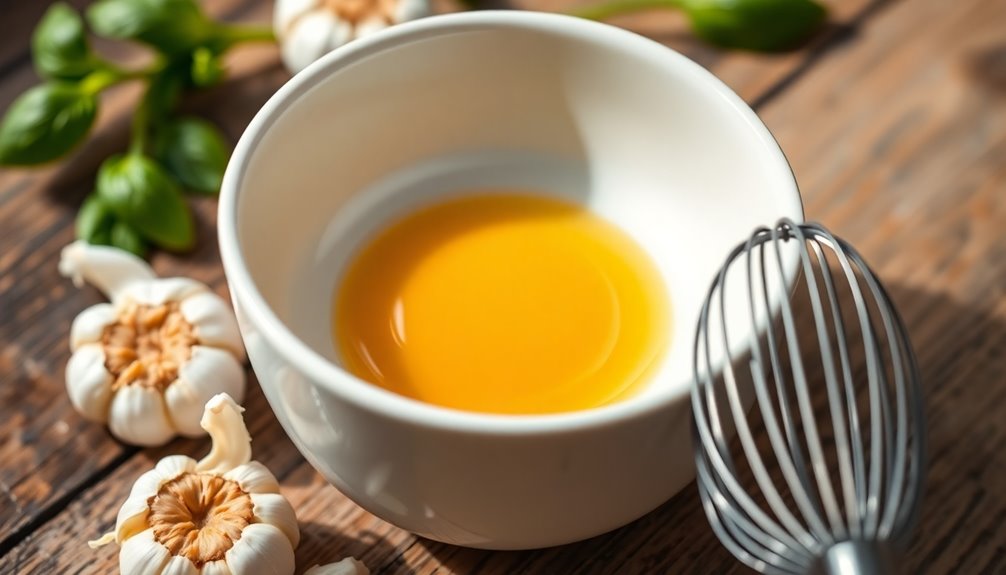
With your garlic cloves prepped and ready, it's time to add the egg yolk, which acts as the emulsifier in your aioli.
Crack an egg and separate the yolk from the white, discarding the white or saving it for another recipe.
Place the yolk in your mixing bowl with the garlic. Use a fork or whisk to blend them together until they form a smooth mixture.
This step is essential, as it helps create a stable base for your aioli. Keep mixing until you achieve a creamy consistency, ensuring the garlic and yolk are well combined.
This foundation will enhance the flavor and texture of your aioli, setting the stage for the next steps in the process.
Step 3. Slowly Drizzle in Olive Oil
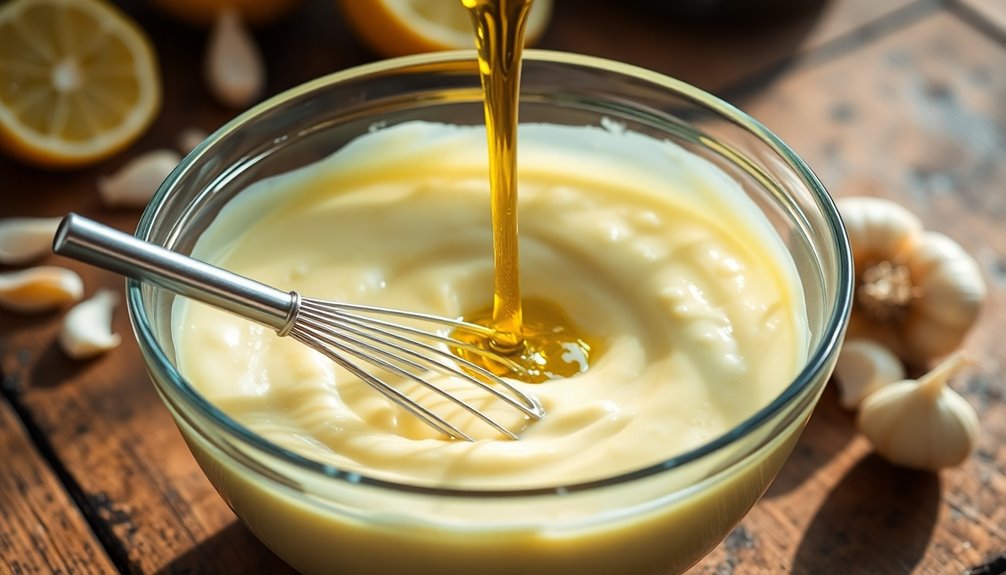
As you continue mixing the garlic and egg yolk, start to slowly drizzle in the olive oil. This step is essential for achieving that creamy texture you want in your aioli.
Use a steady, thin stream of oil, allowing it to emulsify with the garlic and egg mixture. You'll notice the color changing and the consistency thickening as you pour.
Keep whisking vigorously; this helps incorporate the oil effectively. If you add the olive oil too quickly, the emulsion might break, and you won't get that perfect blend. Patience is key here, so take your time.
Once you've added all the oil and achieved a smooth, thick consistency, you're well on your way to making delicious aioli!
Step 4. Incorporate Lemon Juice

Once you've achieved that silky texture with the olive oil, it's time to brighten up your aioli with some lemon juice.
Grab a fresh lemon and cut it in half. Squeeze one half over your aioli, making sure to catch any seeds that might fall in. Start with a tablespoon of lemon juice; you can always add more later if you want a stronger flavor.
Whisk it in thoroughly, allowing the citrus to meld with the garlic and olive oil. Taste your aioli at this point to see if the acidity balances well with the richness.
If you desire more brightness, squeeze in some extra juice, but remember to do it gradually to avoid overpowering the subtle flavors you've created.
Step 5. Season With Salt and Pepper

To elevate the flavor of your aioli, season it with salt and pepper. Start by adding a pinch of salt to your mixture. Stir it in and taste. This step's essential, as it helps bring out the flavors of the garlic and lemon juice.
If you find it lacking, don't hesitate to add more salt gradually. Next, sprinkle in freshly cracked black pepper. This not only enhances the taste but also adds a subtle kick.
Mix everything well and taste again. Remember, the goal is to find a balance that suits your palate. Adjust accordingly, but keep in mind that a little goes a long way.
Enjoy the rich, savory flavor your perfectly seasoned aioli brings to your dishes!
Final Thoughts

While preparing aioli might seem challenging at first, you'll find it's a rewarding culinary skill that enhances countless dishes.
Once you master the basics, you can experiment with flavors and ingredients to create your own signature sauce. Whether you're using it as a dip for veggies, a spread for sandwiches, or a drizzle over grilled meats, aioli adds a rich, creamy texture and a burst of flavor.
Don't be afraid to play around with garlic levels or add herbs for a twist. Remember, practice makes perfect, so keep refining your technique.
Soon, you'll be making aioli with confidence. Embrace this versatile condiment, and watch as it elevates your meals to a whole new level! Enjoy your culinary journey!
Frequently Asked Questions
Can I Make Aioli Without Eggs?
Yes, you can definitely make a version of aioli without eggs!
Instead of using eggs for emulsification, you can rely on ingredients like mustard or aquafaba to achieve that creamy texture.
Start by combining garlic, lemon juice, and your chosen emulsifier. Gradually whisk in oil until you reach your desired consistency.
This egg-free version still packs a flavorful punch and can be a great option for those with dietary restrictions.
Enjoy experimenting!
How Long Does Homemade Aioli Last in the Fridge?
Homemade condiments like aioli can be a delicious addition to your meals, but knowing how long they last is essential.
Typically, homemade aioli lasts about 3 to 5 days in the fridge. To guarantee it stays fresh, store it in an airtight container.
Always check for any off smells or changes in texture before using it, as homemade versions don't have preservatives like store-bought ones.
Enjoy your culinary creations while they're fresh!
What Can I Substitute for Garlic in Aioli?
If you're looking to substitute garlic, you've got a few options.
You can use garlic powder for a milder flavor, or try shallots for a sweeter touch.
For a unique twist, consider using roasted garlic, which has a softer taste.
If you want to avoid all garlic, try adding a bit of lemon zest or even a dash of vinegar for acidity.
Experimenting helps you find the perfect balance for your dish!
Is Aioli Gluten-Free?
Yes, aioli is generally gluten-free, as it typically consists of ingredients like olive oil, egg yolks, lemon juice, and garlic.
None of these ingredients contain gluten, making it safe for those with gluten sensitivities or celiac disease.
However, always check the labels of any pre-made versions, as some may contain additives or preservatives that aren't gluten-free.
When in doubt, making it from scratch guarantees you're keeping it gluten-free and delicious!
Can Aioli Be Frozen for Later Use?
You might be wondering if you can freeze aioli for later use.
The truth is, freezing isn't the best option for this creamy sauce. When you thaw it, the texture can become grainy or separate, which isn't ideal.
If you have leftover aioli, it's better to store it in the fridge and use it within a week. That way, you'll enjoy its fresh taste and smooth consistency.










